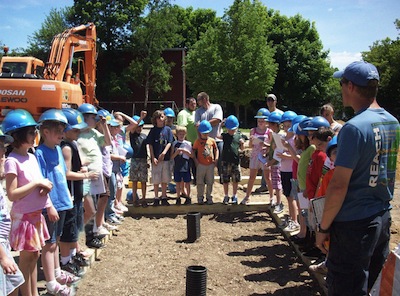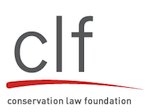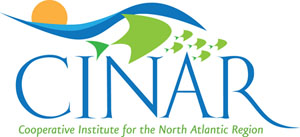A recent retrofit project at the School Street School in Rochester, New Hampshire is helping to reduce stormwater pollution in a tributary of the Cocheco River, while giving local youngsters a hands-on experience in protecting water quality in their community.
The retrofits treat stormwater runoff from the school’s roof, parking lot and other paved surfaces, which in turn will reduce the effects of polluted runoff into Willow Brook. For the school, the project provided an excellent educational opportunity, and a comprehensive program for the students was designed in partnership with the Cocheco River Watershed Coalition.
The city of Rochester Department of Public Works and the University of New Hampshire Stormwater Center installed several low-impact development practices at the K-4 school beginning last spring and continuing through the summer and early fall, including a pervious pavement basketball court, pervious sidewalk, infiltration dry well, and three rain gardens, which the students planted. According to UNH Stormwater Center Director Rob Roseen, approximately 75 percent of stormwater runoff on the site is now being treated through these practices.
Students learned about the retrofit designs happening at their school through several demonstrations and field trips. At one event, called “Touch a Truck Day,” students had the opportunity to talk to the big equipment operators at the Rochester DPW. They also talked to UNH Stormwater Center engineers about the concepts of erosion and filtration, and what was happening in the rain gardens.
After having the opportunity to hear about the project from others, the students then made a five-minute video explaining the importance of what’s happening at their school, and the film is now being shown on the Rochester School’s TV channel.
“If you can repeat the message, then people begin to understand. What we did was build up an educational sequence,” said Lorie Chase, Cocheco River Watershed Coalition Coordinator, who worked on developing the educational components of the project.
One of the school’s teachers commented, “This has been so important for these kids to learn that they can make changes in their surroundings and that their community will help them.”
Community education has also been a part of the project. Earlier this fall, 35 Rochester city and school officials attended an open house at the school to tour the retrofits and learn from the partners about the project.
Funded in part by the New Hampshire Department of Environmental Services Watershed Restoration Grant appropriated through the USEPA under Section 319 of the Clean Water Act, the project is a partnership between the NHDES Watershed Assistance Program, Cocheco River Watershed Coalition, the UNH Stormwater Center, and the Rochester Department of Public Works.
The environmental stewardship initiated by this project has continued into this school year with participation in the Trout in the Classroom Project, coordinated by the New Hampshire Fish and Game Department and Great Bay Trout Unlimited. Students will now try their hands at habitat restoration, including learning about fish habitat, receiving trout eggs and a tank, caring for the fish until the spring, and then releasing them into Willow Brook.
Catherine Coletti works with the New Hampshire Coastal Program in Portsmouth, New Hampshire, on outreach project planning and reducing nitrogen pollution in the coastal watershed. An R.I. native, she earned her degree in environmental conservation and journalism from the University of New Hampshire and has lived in N.H. since.
Print



















